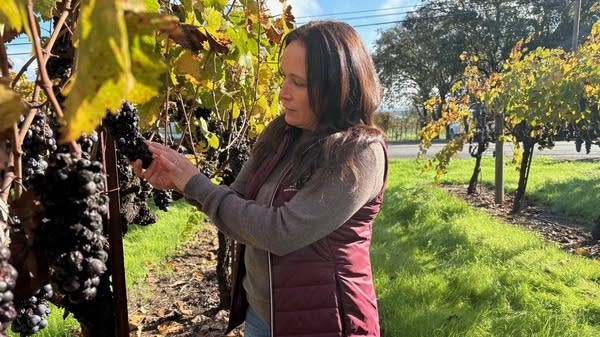You probably waste more food than you think — and it's costing you
Tracking food waste can save you hundreds — maybe even thousands — of dollars a year. Here are some expert tips for how to eat what you buy and buy only what you will eat.

Three-quarters of a red onion, slimy and rotten. Half a banana, black and mushy. A bottle of Diet Coke, flat.
These are just a few things I recently threw out after inspecting the inside of my refrigerator. Despite my best intentions, I often let food go bad because I forget what I have or don’t end up cooking aspirational recipes like rutabaga fondue — the rutabaga rotted before I got around to it.
Statistics tell us you're probably like me. You don’t want to waste food, but you do. Up to 40% of the food sold in the U.S. for human consumption ends up in the trash. And it’s costing consumers a lot of money at a time when food prices are at a record high.
“I’m always surprised how people will make decisions at the grocery store about what to buy based on savings of 10 or 20 cents, and yet that math goes out the window when they go home,” said Dana Gunders, president of ReFED, a nonprofit that advocates for evidence-based solutions to cut food waste.
Food waste costs the average person in the U.S. about $14 a week or $728 a year, according to new Environmental Protection Agency estimates published this month. A typical family of four therefore spends $56 a week or close to $3,000 a year on food they end up never eating, money they could be saving or using to pay off debt or for other expenses.
The EPA defines food waste as any fresh or manufactured food produced for humans that doesn't get eaten. That includes leftovers fed to pets, and food that ends up in the compost.
Most people don't think of food waste as a personal problem.
“A lot of us really aren't aware of how much we waste and so, but most of us probably also don't want to go to great lengths to track it, because maybe we don't want to know that answer,” said Brenna Ellison, a professor of agricultural economics at Purdue University.
“Measuring it is the first step to being able to do anything about it,” she said.
The federal government pledged in 2015 to cut the nation's food waste in half by 2030, though it's unlikely to meet the target. Many state and municipal governments have spearheaded their own efforts to halve local waste, including Hennepin County, Minnesota, which is home to Minneapolis. The county launched a "Trash or Cash" campaign last year to motivate thrifty residents to conserve more.
“A lot of times, we are told, ‘You need to go talk to that grocery store. You need to talk to the restaurant. They're wasting so much food,’” said Jenny Kedward, a food waste prevention specialist for Hennepin County.
"People don't necessarily see themselves as a big contributor to it … but any research that you look at, [food waste at home] make up the biggest sector wasting.”
Inedible scraps like banana peels, avocado skins and chicken bones often get counted when measuring waste, but almost two-thirds of what Americans toss is stuff that’s edible, Kedward said.
The average person tosses 473 grams of food, or a little more than a pound, every week, according to the latest data from an ongoing national household food waste tracking survey, led by researchers at The Ohio State University.

Date labels on food products drive a large amount of that food waste. With the exception of baby formula, the federal government doesn't regulate dates on packaging, leaving it up to food producers and brands' discretion. Dates tacked onto words like “use by,” “best by,” or “expires on” rarely indicate that a food is unsafe to eat. Instead, they tend to estimate when food quality starts to decline.
Date labels are just “suggestions,” said Irene Li, a Boston-based chef and restaurateur and co-author of the cookbook, “Perfectly Good Food: A Totally Achievable Zero Waste Approach to Home Cooking.”
“They are from the manufacturer who really has a vested interest in you buying a lot of the product and eating it only at its peak,” Li said. She recommends home cooks trust their senses, especially smell, over any date on a product.
Yet 43% of people always or usually discard food near or past the date on the label, and 88% do so at least occasionally, according to a 2025 Harris Poll-Johns Hopkins School of Public Health survey.
Waste levels also depend on the time someone can devote to activities like food planning, storing and cooking, the strength of their food management skills and how much time they spend at home.
“People want to minimize their food waste, but it's difficult, especially just with all the time constraints that we have. We can plan, but life happens,” said Kathryn Bender, an assistant professor of economics at the University of Delaware.
The national survey data showed food waste at home jumped from 2021 to 2022 despite higher inflation, Bender said. The amount of waste correlated with an uptick in people unexpectedly eating more of their food away from home.
“Food waste did get better when more people were at home [during the pandemic]," Bender said. “They had more time then, but as we kind of returned to our chaotic lifestyles, we saw it get harder to manage it.”
Absent a power outage spoiling everything in your fridge, food waste tends to happen little by little. Bender recommends taking action to conserve more food little by little as well.
“It's not about changing all your behaviors at once, but saying, ‘What can I do in the next hour or next day or the next week to try to help reduce my food waste?’ Smaller changes tend to be more achievable, and they’ll stick around longer,” Bender said.
Here are some more expert tips to conserve more of our food:
Track your waste
“The biggest thing anyone can do is actually just stop and look at what they're wasting.”
— Jenny Kedward, food waste prevention specialist, Hennepin County, Minnesota
Put a piece of paper on the front of your fridge and write down everything you throw out for a week. Note the reason why you chose to throw it out.
Maybe you bought too much of something or the wrong items, an ingredient was partially used but the rest spoiled, your produce became wilted or damaged, or you just forgot about it.
Use this information to help plan future meals and grocery shopping.
If you prefer a digital way to track your food waste, check out this free food waste tracker app.

Do a fridge check once a week
“What's at the back of your cabinet, the back of your freezer, the back of your fridge? Bring those things to the front and make sure you're using them early.”
— Kathryn Bender, economist, University of Delaware
Select a day to inventory everything in your fridge. Challenge yourself to use the things that look like they’ll go bad first.
Consider moving those items to a specific part of your fridge where it will be easy to access, like a basket on the top shelf labeled “Eat First.”
Use this Fridge Check guide to help you audit your fridge, freezer and pantry. Hennepin County also has a Fridge Check Friday email if you need a weekly nudge, which you can sign up for even if you live outside Minnesota.
Use the freezer
“I just put baby spinach straight in the freezer now. I don't even pretend that I’m going to eat it raw in a salad. Like, who are we kidding here?”
— Irene Li, chef, restaurateur and coauthor of the cookbook, “Perfectly Good Food”
You can freeze more than you think, including nuts, most dairy (cheese, butter, milk), sliced bread and meat.
Freezing leftovers can also reduce waste, especially if you don’t want to eat the same meal multiple times in a row. ReFED reported people who throw out leftovers waste nearly four times as much food as people who infrequently throw them away.
Trust your senses
"If you take a big whiff and it smells OK, that's usually a pretty good sign."
— Margaret Li, coauthor of the cookbook, "Perfectly Good Food"
Date labels prompt a supermajority of people to throw out food that may still be safe to eat. Rather than looking at dates on packaging, look at the food, smell it and feel it to figure out whether or not it is safe to eat.
If you smell something rancid or foul, you see sliminess or mold, or the texture's gone mushy, tossing food into the compost is the surest way to protect yourself from food poisoning.
For more tips on how to safely store specific food items and extend their shelf life, check out the website StillTasty.com.
Shop less, stick to the list
“The best way people could reduce [their waste] is just to produce less to begin with, right? That might mean buying less food.”
— Brenna Ellison, economist, Purdue University
When we pop into grocery stores fewer times a week, we tend to waste less. A hack for better planning is limiting the number of times you go to the store, which can also limit impulse purchases.
Treat recipes like guidelines
“Start with what you have on hand. If you cook that way, you really slash the amount of food going to waste.”
— Anne-Marie Bonneau, author of “The Zero-Waste Chef”
Some meals, think frittatas or stir fries, are more flexible than others. Recipes that read more like guides than directives can help you use up what you already have. Why not try making "clear out the fridge" soup, "eat all your vegetables" pancakes or this no-recipe recipe for smoothies.
When you’re missing ingredients for a specific recipe, see if you have something else that would easily substitute or perhaps just make it without. The more you experiment, the more confident you’ll become when you cook.
Visit Margaret Li's website, Food Waste Feast, for useful substitution guides for various ingredients.







!["I think [AI] is really cool. There is stuff out there that is fun to watch," said Bella Falco of Denver, Colorado. "There are also things that starting to really scare me, like fake creators."](https://img.apmcdn.org/cb0a9a7e54db934026285b941f4b74ded3dab5ea/widescreen/53f6b2-20251113-bella-falco-sitting-on-a-striped-couch-with-a-mug-600.jpg)





